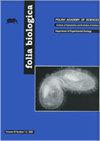Differentiation of the domestic pig and wild boar using genotyping-by-sequencing
IF 0.8
4区 生物学
Q4 BIOLOGY
引用次数: 0
Abstract
Domestic pigs and wild boars have undergone frequent interspecies crossbreeding; therefore, the presence of hybrids makes it challenging to find genetic markers that distinguish both subspecies. The aim of this research is to identify the DNA regions that underwent strong selection during the domestication of the pig and to give an insight into the genetic diversity of the Polish wild boar and domestic pigs by implementing the genotyping-by-sequencing (GBS) technique. We studied two groups of animals: one consisted of domestic pigs (Landrace, Large White, Duroc, Puławska and Pietrain), while the second group included wild boars from Poland. The filtered single nucleotide polymorphisms (SNP) panel used in this study included 7,298 markers that were spread across 18 porcine autosomes and unmapped contigs. The maximum-likelihood phylogenetic trees and multidimensional scaling (MDS) clearly separated the populations of pigs from the wild boars. We also detected genome regions that demonstrated the most significant genetic differences between the domestic pigs and wild boars. These regions were distributed on eight different autosomes and overlapped with 48 different pig RefSeq genes. The KEGG pathway, Reactome and GO terms were further used to assign a functional significance to the identified genes that were associated with inter alia muscle development (MYOG, MEOX2), pre-weaning mortality stress (MYO7A) and sensory perception (TAS1R3).测序基因分型技术在家猪和野猪鉴别中的应用
家猪和野猪经常进行种间杂交;因此,杂交种的存在使得寻找区分这两个亚种的遗传标记具有挑战性。本研究的目的是通过实施测序基因分型(GBS)技术,识别在猪驯化过程中经过强烈选择的DNA区域,并深入了解波兰野猪和家猪的遗传多样性。我们研究了两组动物:一组由家猪组成(长白猪、大白猪、杜洛克猪、普瓦夫斯卡猪和皮特兰猪),而第二组包括来自波兰的野猪。本研究中使用的过滤单核苷酸多态性(SNP)小组包括7298个标记,分布在18个猪常染色体和未映射的重叠群中。最大似然系统发育树和多维标度(MDS)清楚地将猪和野猪的种群分开。我们还检测到了显示家猪和野猪之间最显著遗传差异的基因组区域。这些区域分布在8个不同的常染色体上,并与48个不同的猪RefSeq基因重叠。KEGG通路、Reactome和GO术语被进一步用于为已鉴定的与肌肉发育(MYOG、MEOX2)、断奶前死亡应激(MYO7A)和感觉感知(TAS1R3)相关的基因赋予功能意义。
本文章由计算机程序翻译,如有差异,请以英文原文为准。
求助全文
约1分钟内获得全文
求助全文
来源期刊

Folia Biologica-Krakow
医学-生物学
CiteScore
1.10
自引率
14.30%
发文量
15
审稿时长
>12 weeks
期刊介绍:
Folia Biologica (Kraków) is an international online open access journal accepting original scientific articles on various aspects of zoology: phylogeny, genetics, chromosomal studies, ecology, biogeography, experimental zoology and ultrastructural studies. The language of publication is English, articles are assembled in four issues per year.
 求助内容:
求助内容: 应助结果提醒方式:
应助结果提醒方式:


